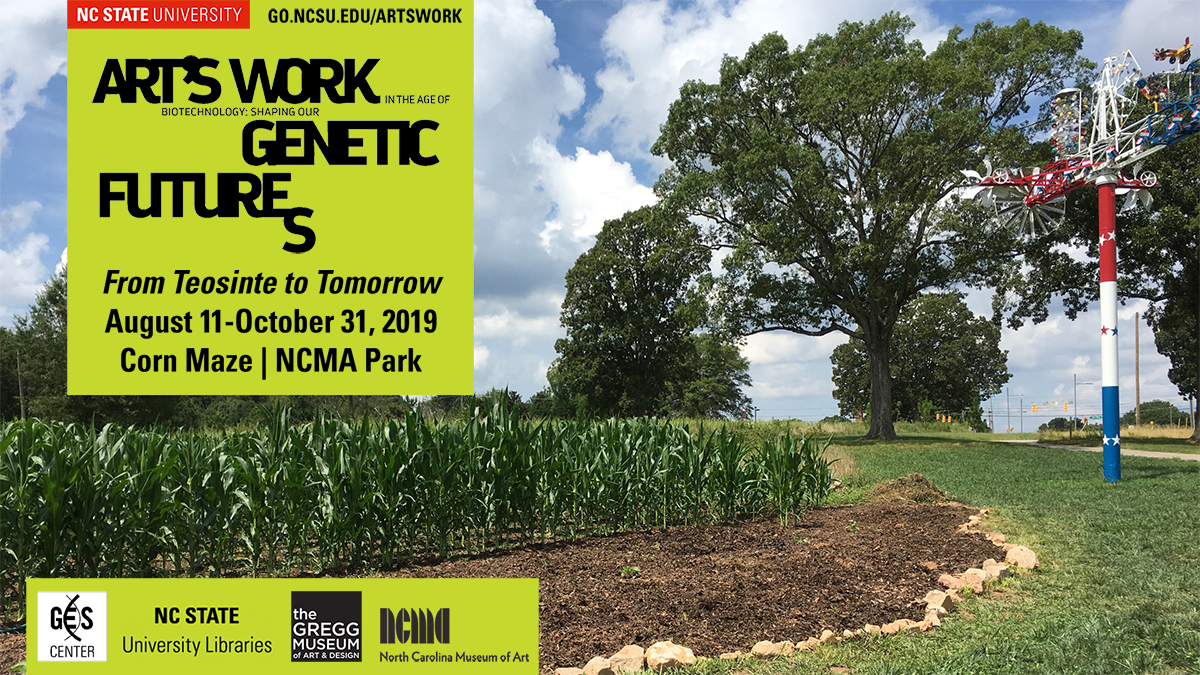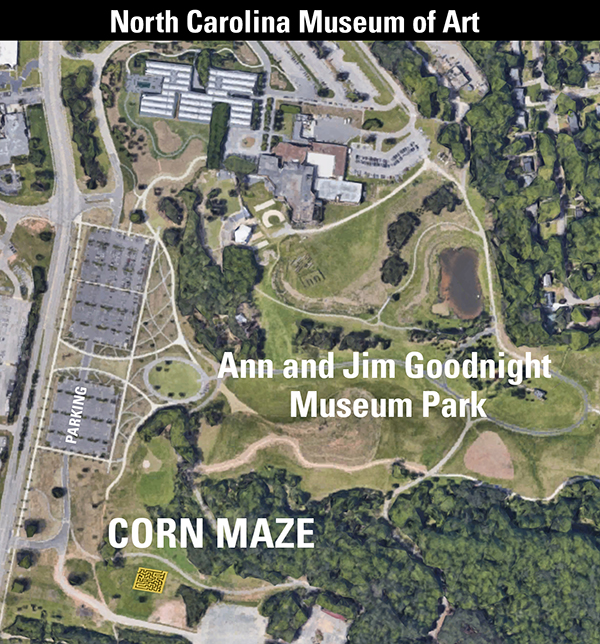
- This event has passed.
Corn Maze: From Teosinte to Tomorrow

Part of the upcoming Art’s Work in the Age of Biotechnology: Shaping Our Genetic Futures art exhibit, the 100’ x 100’ corn maze has its opening event on Sunday, Aug. 11 at 3:00 p.m. Locopops and the El Molcajete food truck will have refreshments for sale. The event is free and open to the public. After this opening event, the corn maze will remain open and accessible during museum park hours. The maze will be open through the end of October.
This corn maze is a time machine.
At the heart of From Teosinte to Tomorrow, a quarter-acre stand of non-GMO tropical field corn, you will find an interior room with a raised bed of teosinte, the wild grass thought to be an ancestor of modern corn.
Once there, you will have traveled thousands of years into civilization’s agricultural past, through generations of cultivation practices developed by farmers across the American continents as well as by contemporary biotechnologists. Through countless harvests, the skinny, hard kernels of teosinte grass were gradually hybridized into today’s juicy and sweet corn on the cob.
As humanity struggles with challenges like global population growth and climate change, there is a growing disconnect between first-world populations, the sources of our food, and the people who labor to grow it and deliver it. As one of the earliest cultivated grains in the western hemisphere, the cultural significance of maize (Zea mays) invites conversations about these issues as well as about issues of class, identity, community, and genetics in society.
From Teosinte to Tomorrow was inspired by artist Josef Albers and based on his photographs and drawings during the years he and Anni Albers traveled extensively in Mexico (1930s–60s). The Albers’ deep connection to Mesoamerican art, together with their importance to the growth of art and design in North Carolina, made these reflective works an apt inspirational source for NC State University Libraries exhibit designer Molly Renda and design collaborator William Dodge.
From Teosinte to Tomorrow is funded by the NC State University Libraries’ Goodnight Educational Foundation Endowment for Special Collections with additional support from the Genetic Engineering and Society Center, and in-kind donations from the College of Agriculture and Life Sciences, the JC Raulston Arboretum, Hanbury, and the North Carolina Museum of Art.
This exhibit is part of the multi-site exhibition Art’s Work in the Age of Biotechnology: Shaping Our Genetic Futures (October 17, 2019–March 15, 2020), an art-science exhibition organized by the NC State University Libraries and the Genetic Engineering and Society Center, and shown at the Gregg Museum of Art & Design, in the physical and digital display spaces of the Libraries, and here at the North Carolina Museum of Art Ann and Jim Goodnight Museum Park. For more information visit go.ncsu.edu/artswork
WordPress database error: [Unknown column 'wp_tec_occurrences.start_date' in 'SELECT']SELECT SQL_CALC_FOUND_ROWS wp_posts.*, CAST( wp_tec_occurrences.start_date AS DATETIME ) AS event_date
FROM wp_posts LEFT JOIN wp_term_relationships ON (wp_posts.ID = wp_term_relationships.object_id) LEFT JOIN wp_postmeta ON ( wp_posts.ID = wp_postmeta.post_id AND wp_postmeta.meta_key = '_EventHideFromUpcoming' ) LEFT JOIN wp_postmeta AS mt1 ON ( wp_posts.ID = mt1.post_id )
WHERE 1=1 AND wp_posts.ID NOT IN (13539) AND (
wp_term_relationships.term_taxonomy_id IN (189,454,702,703,704)
OR
wp_term_relationships.term_taxonomy_id IN (47,518,700)
) AND (
wp_postmeta.post_id IS NULL
AND
( mt1.meta_key = '_EventStartDate' AND CAST(mt1.meta_value AS DATETIME) >= '2026-01-05 12:33:47' )
) AND wp_posts.post_type IN ('post', 'page', 'attachment', 'tribe_venue', 'tribe_events', 'tribe_event_series') AND ((wp_posts.post_status = 'publish'))
GROUP BY wp_tec_occurrences.occurrence_id
ORDER BY event_date ASC, wp_posts.post_date ASC
LIMIT 0, 3
